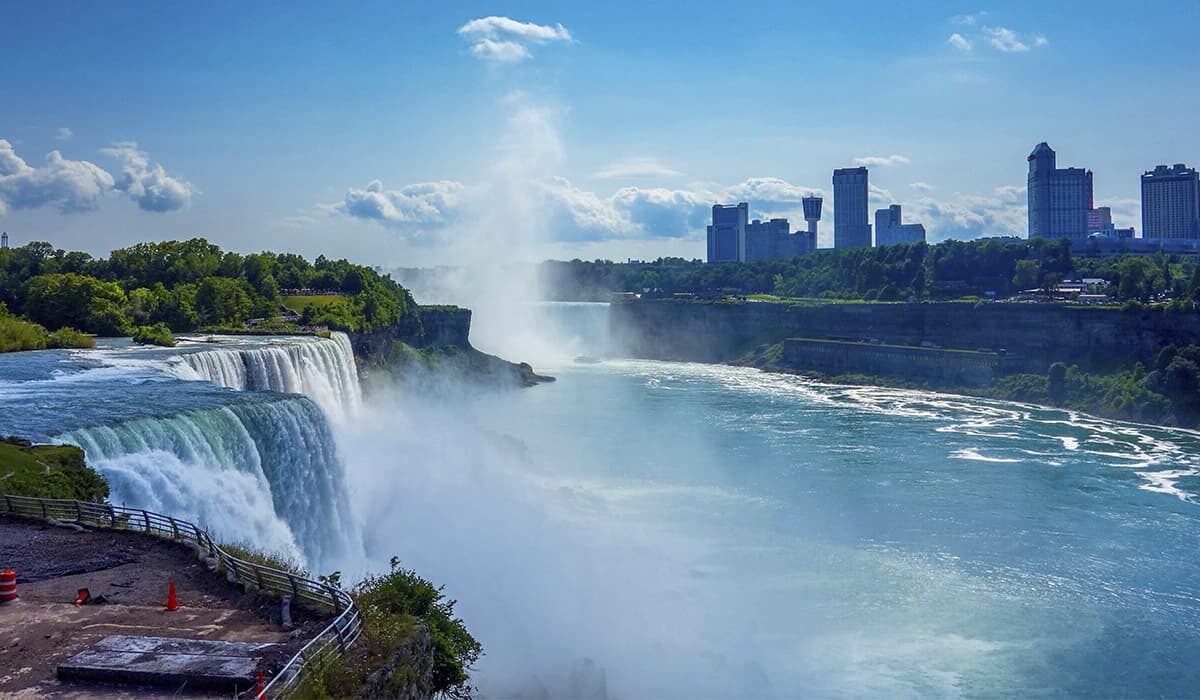On the U.S.-Canadian border, between Lakes Erie and Ontario, where the Niagara River gently approaches the rapids, is the massive Niagara Falls, which drop huge torrents of water from the height of a 20-story building. Niagara Falls is three waterfalls, united for simplicity by a common name: “Canadian” (aka “Horseshoe”), “American” and “Veil of the Bride” Falls.
It is better to admire this miracle of nature from the Canadian side, where you can almost closely approach the “Horseshoe”, the ridge of which stretches for 670 meters, and the water falls into the abyss from a 57-meter ledge. A few hundred meters below, the Rainbow Bridge spans the Niagara River for vehicular and pedestrian traffic between the two countries.
Above the bridge are spectacular views of the rainbow: it appears in clear weather when the sun’s rays, crossed by the spray, are refracted. Niagara Falls got its sonorous name thanks to the Native American tribes, who called it “Onguiaahra”, which means “Thunder Water” in Iroquois. Even at a distance of many kilometers you can hear the noise of the waterfall and see the “water cloud” overhanging it, enveloped by a myriad of splashes.
Niagara Falls – A Creation of Nature
Niagara Falls have a history of 12,000 years. The formation of the Niagara River and the Great Lakes was caused by a Wisconsin glacier moving from eastern Canada. Like a powerful tractor, the ice sheet tamped down soil and rocks, created new riverbeds and filled in old ones.
After the glacier melted, the Niagara River ran into dolomite rocks and began to erode them, and from the north shore the river washed away the sea rocks, forming a gorge and a bluff. Soil erosion continues today, so Niagara Falls moves upstream by one meter each year. Scientists predict that in 20,000 years it will reach Lake Erie and dissolve into the waters of Ontario.
The legend and history of Niagara Falls
Niagara Falls is steeped in a romantic legend. It says that the beautiful Lelavalae girl was about to be married off to a tribesman she despised. To avoid such a fate, the beauty decided to sacrifice herself to the thunder god He-No. She threw herself down from the ledge of a waterfall, but He-No caught her in flight, and since then their souls have lived in one of Niagara’s gorges. According to official history, the first European to see and describe Niagara Falls was the Catholic priest Louis Annepen, who traveled through the area in 1677.
Niagara Falls Tours and Activities
As the most powerful waterfall in North America, Thundering Water attracts up to 12 million tourists each year. Hotel complexes have been erected on both sides of the river. You can enjoy the spectacle of falling water not only from the shore, but also from the windows of the hotels, during boat rides or helicopter tours. Travelers will also be offered to climb to the observation deck of the 236-meter Skylon Tower, fly over Niagara in a hot-air balloon, or descend into the “Cave of the Winds” to the foot of the Fata Falls. And, of course, it’s impossible to miss the evening illumination and fireworks at Niagara Falls. Most people just admire what they see, but there are brave people who want to conquer the water element.
Extreme fun in Niagara Falls
Since the late 19th century, an extreme pastime has been common in Niagara Falls – going down in barrels. In 1901 an American teacher Annie Taylor became the first person in the world who has overcome the falls in a wooden barrel and survived. The “record holder” only got away with a small head wound. Extremes have survived with serious injuries. Often such a venture also ended in the death of the daredevil. Only one man, stuntman Steve Trotter, who survived the fatal stunt, had the guts to jump again. In 1985, Steve Trotter went down Niagara Falls in a barrel for the first time, but it took him 10 years to get up the courage for a second attempt before he successfully repeated the “barrel drop.”
Niagara Falls in Winter
Niagara is beautiful not only in summer but also in winter. In the cold, the stream continues to plummet and the water frozen at the bottom of the falls forms gigantic icicles, sparkling and shimmering in the sunlight. It is hard to imagine that Niagara Falls, which drops 5,900 cubic meters of water from its ledge every second, could have stopped. However, it happened twice – in 1848 and 1911. In the winter of 1848, the weather was so bad that blocks of ice from Lake Erie blocked the Niagara Falls’ source, and the falls stopped rumbling. Residents, who did not understand the reason for the incident, were not in the least bit worried, expecting anything, up to the end of the world. But twenty-four hours later, the water broke through the ice barrier and rushed down, smashing huge blocks of ice with a roar and rumbling, disappearing into a p

